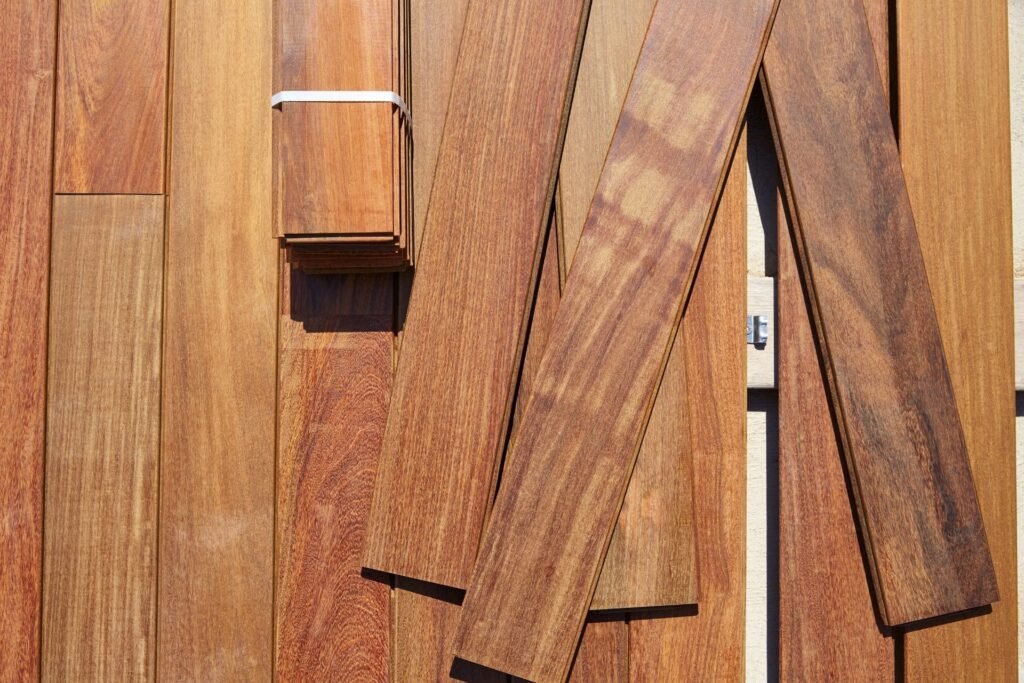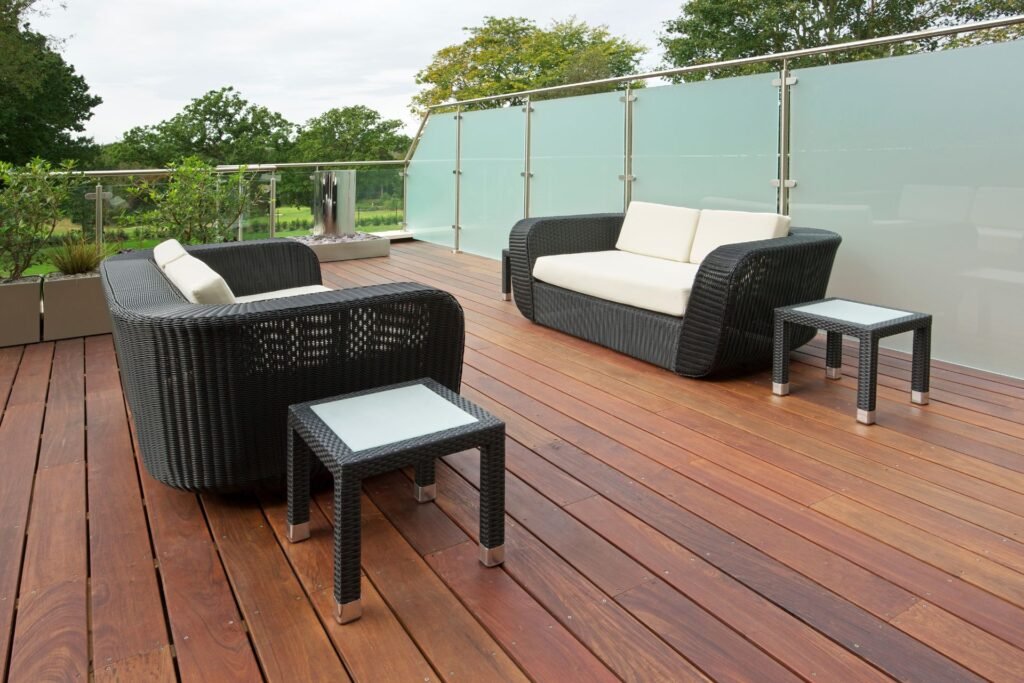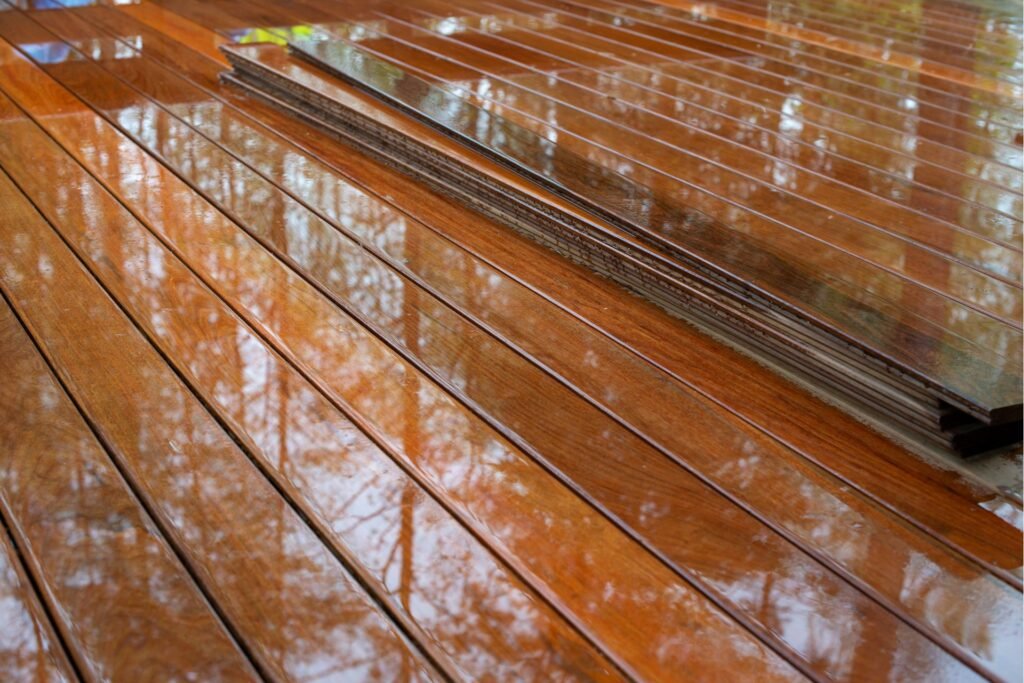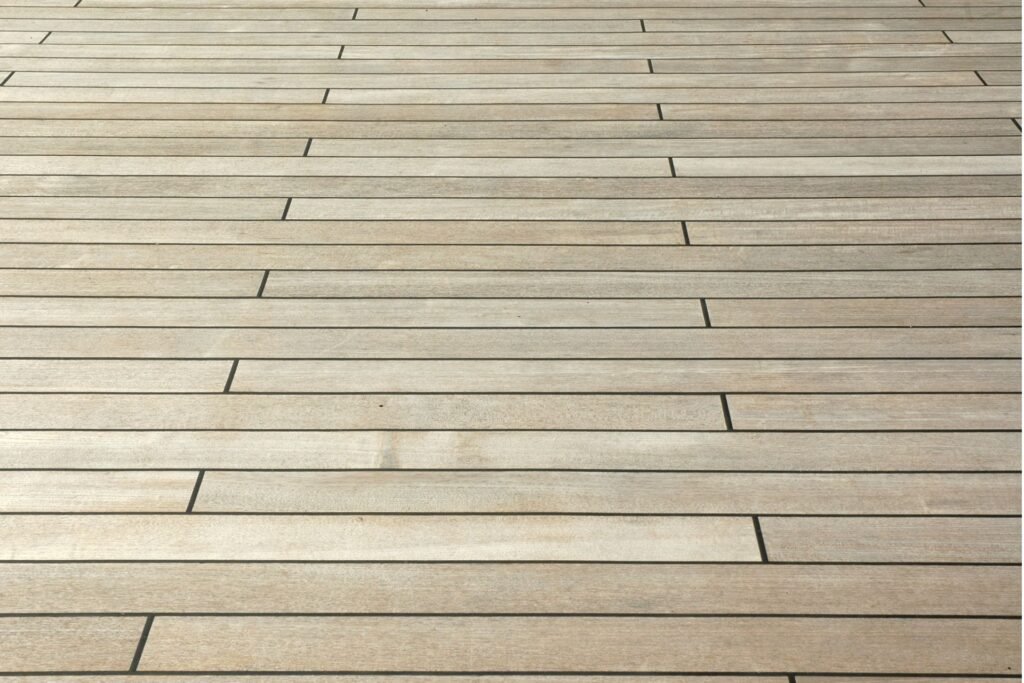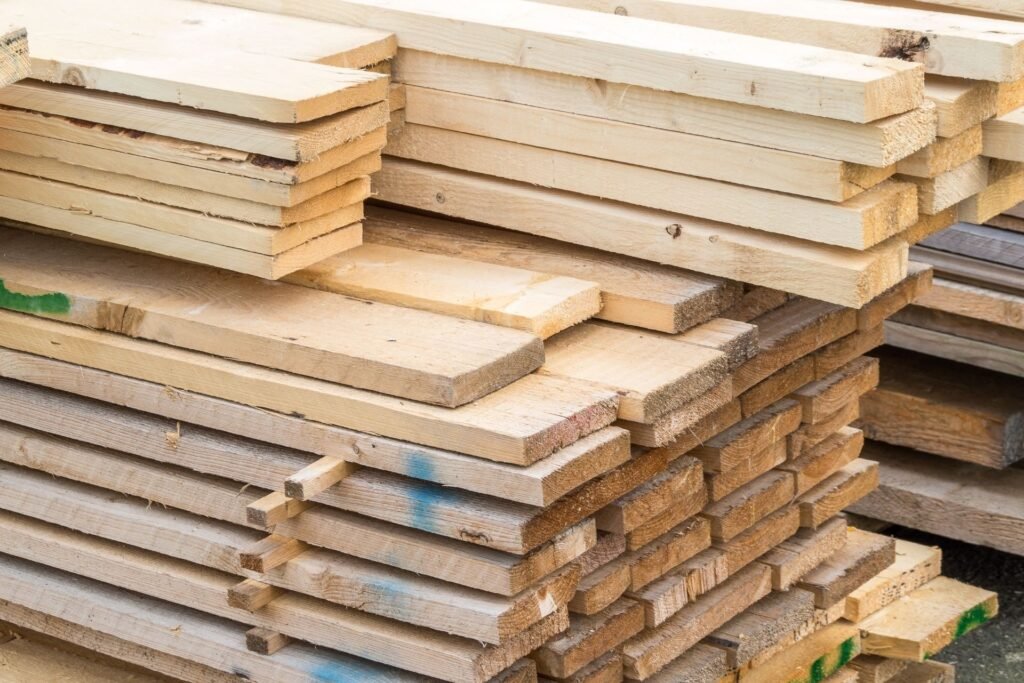
Ultimate Guide To Timber Vs Composite Decking Australia
Welcome to our comprehensive guide on choosing the right decking material for your Australian home, where selecting the perfect decking is crucial for enhancing your outdoor living spaces. This decision significantly affects your home’s aesthetics and value and must withstand the Australian climate’s unique challenges, from scorching sun to torrential rains. Homeowners often find themselves in a dilemma: the natural charm and warmth of timber decking or the durability and low maintenance of composite materials? Our guide aims to navigate you through the pros and cons of timber vs composite decking, specifically tailored for Australian homes. We’ll explore what makes each material stand out, their longevity in our local climate, and weigh their costs and sustainability. By the end of this guide, you’ll have all the necessary information to make an informed decision that aligns with your lifestyle, budget, and aesthetic preferences, ensuring your outdoor space is transformed into a place where memories are made.
Choosing the right decking material is crucial for Australian homeowners looking to enhance their outdoor spaces. Timber decking offers natural charm and warmth, popular for its aesthetic appeal, with species like Merbau, Spotted Gum, and Jarrah being favorites. It’s typically more cost-effective upfront but requires regular maintenance to combat weather, pests, and decay. On the other hand, composite decking, made from wood fibers and plastics, presents a modern alternative that boasts durability, low maintenance, and resistance to the elements. While it may lack the natural look of timber and come with a higher initial cost, its longevity and minimal upkeep make it a strong contender. Ultimately, the choice between timber and composite decking in Australia depends on individual preferences, lifestyle, budget, and the specific climate challenges of the location.
- Understanding Decking Materials
- Why Decking Choices Matter In Australia
- Timber Decking: A Classic Choice
- Composite Decking: The Modern Alternative
- Cost Comparison: Timber Vs Composite In Australia
- Environmental Impact And Sustainability
- Installation And Maintenance: What Australians Need To Know
- Making The Right Choice For Your Australian Home
- FAQs: About Timber Vs Composite Decking Australia
- Conclusion
- Menu
Understanding Decking Materials
Creating an engaging outdoor space has always been a cherished goal for many homeowners in Australia. Over the years, decking has emerged as a key component of this endeavor, offering a perfect blend of aesthetic appeal and functionality. At the heart of decking projects are the materials used, primarily timber and composite, each with its own story and set of benefits. Understanding these materials is crucial for anyone looking to create or upgrade their outdoor living space. Let’s delve deeper into what timber and composite decking materials entail, along with a brief overview of the history and evolution of decking materials in Australia.
Timber Decking: A Classic Choice
Timber decking is synonymous with natural beauty and warmth. Sourced from trees, it’s the traditional choice for decking in Australia and around the world. Timber options range from local hardwoods like Jarrah, Spotted Gum, and Blackbutt, to softwoods like Treated Pine. Hardwoods are prized for their durability and resistance to the elements, while softwoods are often chosen for their affordability and ease of installation. Timber decking requires regular maintenance, including sealing and oiling, to protect against weathering, insects, and decay. However, for many, the effort is well worth the reward of a stunning, natural outdoor space.
Composite Decking: A Modern Alternative
Composite decking represents the innovation in outdoor flooring, blending aesthetics with practicality. Made from a mix of wood fibers and recycled plastics, composite decking offers a sustainable alternative to traditional timber. It’s designed to mimic the look and feel of wood while providing enhanced durability and minimal maintenance. Composite decks are resistant to fading, staining, scratching, and mold, making them an appealing choice for those seeking a low-care solution. Available in a variety of colors and finishes, composite decking has gained popularity for its versatility and environmental benefits.
The Evolution of Decking Materials in Australia
The history of decking in Australia is a tale of adaptation and innovation. Initially, timber was the sole option, with local hardwoods being the material of choice for their natural durability and strength. Over the years, as environmental awareness and technology advanced, the introduction of treated pine provided a more sustainable and cost-effective alternative to hardwoods. The turn of the century brought with it a significant shift towards composite materials, driven by the demand for more durable, low-maintenance decking solutions that still offered the beauty of natural wood.
This evolution reflects broader trends in Australian construction and outdoor living, highlighting a move towards sustainability, durability, and ease of maintenance. As homeowners become more environmentally conscious and seek out materials that offer both aesthetic appeal and longevity, the popularity of composite decking is likely to continue to rise.
Whether you’re drawn to the natural charm of timber or the durability and sustainability of composite materials, understanding the options available is the first step towards creating your ideal outdoor space. Each material has its unique benefits and considerations, making it important to assess your needs, maintenance willingness, and environmental priorities. As decking materials in Australia continue to evolve, the future of outdoor living spaces looks both beautiful and sustainable, reflecting the country’s love for the great outdoors and commitment to preserving it for generations to come.

Why Decking Choices Matter In Australia
Crafting the perfect outdoor living space is a quintessential part of the Australian lifestyle. With our love for the outdoors and the unique Australian climate, selecting the right decking materials becomes not just a matter of aesthetics but of durability and longevity as well. In this guide, we delve into why decking choices are so crucial in Australia, emphasizing the impact of our distinctive climate and outdoor culture on these decisions.
Understanding the Unique Australian Climate
Australia’s climate is as diverse as its landscape, ranging from the humid tropics of the North, the arid deserts of the interior, to the temperate regions of the South. This vast array of weather conditions demands materials that can withstand extreme heat, humidity, and even the salty air of coastal regions. The right decking material must, therefore, be resilient enough to endure the scorching sun without fading, warping, or splintering, and also capable of resisting rot and decay from moisture and humidity.
Embracing the Australian Outdoor Lifestyle
Australians have a deep-seated connection with the outdoors. From barbecues with friends and family to quiet evenings spent enjoying the natural beauty of our surroundings, our outdoor spaces are extensions of our homes and reflections of our lifestyle. This love for outdoor living makes it essential to choose decking that is not only durable but also complements our homes and gardens. The ideal decking should offer a seamless transition between indoor and outdoor spaces, enhancing the overall look and feel of our homes while providing a functional and comfortable outdoor area.
The Importance of Durable, Long-lasting Materials
Given the Australian climate’s demands and our passion for outdoor living, the significance of selecting durable, long-lasting decking materials cannot be overstated. Materials such as treated timber, composite decking, and aluminum offer various benefits tailored to meet these needs. Treated timber, for instance, offers a natural look that many homeowners desire, while composite decking provides exceptional durability and minimal maintenance. Aluminum decking, though less common, offers unmatched longevity and resistance to fire, making it an excellent choice for bushfire-prone areas.
Choosing the right decking material involves balancing aesthetic preferences with practical considerations such as maintenance, durability, and climate resilience. It’s not just about creating a visually appealing outdoor space; it’s about crafting an area that can withstand the test of time and the elements, ensuring that your investment remains beautiful and functional for years to come.
In conclusion, the choice of decking is a critical decision for Australian homeowners, deeply influenced by our unique climate and outdoor lifestyle. By selecting materials that are durable, long-lasting, and suitable for our diverse weather conditions, we can create outdoor spaces that not only enhance our quality of life but also add value to our homes. Whether you’re renovating an existing deck or embarking on a new build, understanding the importance of this choice is the first step towards creating a durable, beautiful, and functional outdoor living area.
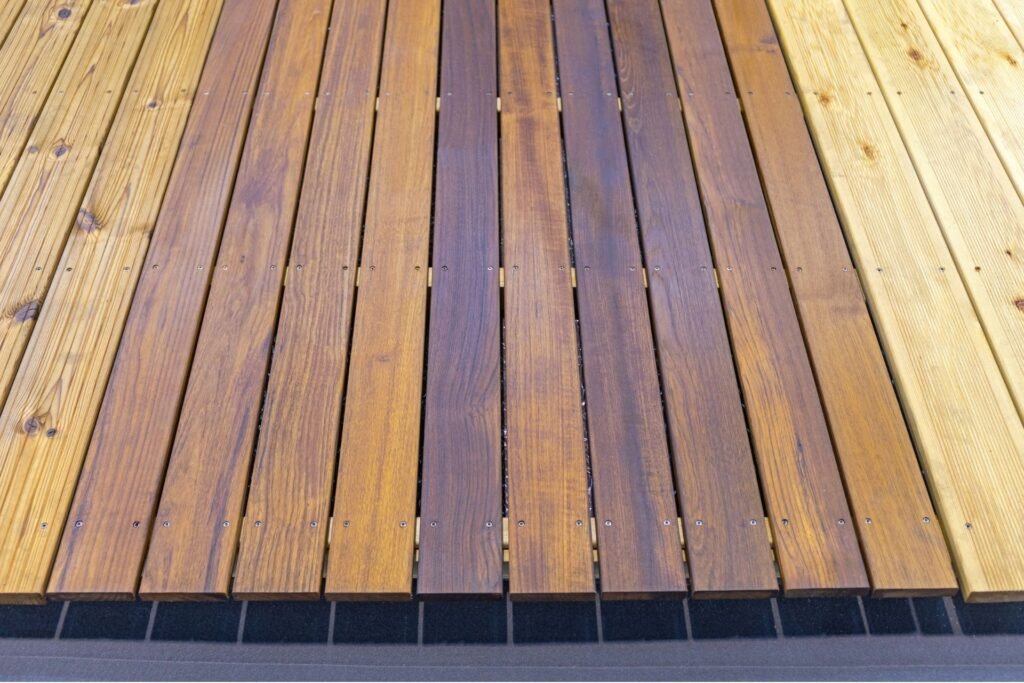
Timber Decking: A Classic Choice
Timber decking is often the heart of an outdoor living space, offering a seamless transition from the indoors to the natural world outside. This classic choice for decking owes its popularity to the warm, inviting feel it brings to any home, perfectly complementing the Australian love for the great outdoors. In this comprehensive guide, we’ll explore the unique charm of timber decking, delve into the types of timber that are a hit in Australia for decking projects, and weigh the advantages and disadvantages to help you make an informed decision.
The Natural Appeal of Timber Decking
Timber decking stands out for its unparalleled natural look and feel, which can hardly be replicated by synthetic alternatives. The organic textures and hues of wood bring a sense of tranquility and earthiness to outdoor spaces, making them feel like a natural extension of the landscape. It’s this connection to nature that makes timber decking a perennial favorite among homeowners who wish to create a cozy, welcoming outdoor area.
Popular Timber Types in Australia
Australia is home to a vast array of timber species, each offering its unique characteristics and benefits for decking. Among the most sought-after types are Merbau, Spotted Gum, and Jarrah, thanks to their durability, stunning appearance, and suitability for outdoor use.
Merbau: Known for its rich, dark tones, Merbau is highly resistant to decay and termites, making it a long-lasting choice for decking.
Spotted Gum: This timber is celebrated for its strength and versatility, featuring a beautiful range of colors from light brown to deep reds. Spotted Gum is also resistant to fire, making it ideal for bushfire-prone areas.
Jarrah: With its deep red hue and exceptional durability, Jarrah is a premium choice for decking. It’s resistant to weather, rot, and pests, offering a long lifespan with proper maintenance.
Advantages of Timber Decking
Timber decking is not just about aesthetics; it offers several practical benefits that make it an attractive option for many homeowners.
Natural Look and Feel: The authentic textures and colors of wood enhance the beauty of outdoor spaces, providing a warm and inviting ambiance.
Potentially Less Upfront Cost: Compared to some synthetic alternatives, timber decking can be more affordable, offering a cost-effective solution for creating your dream outdoor area.
Sustainability: Certain types of timber, like those sourced from managed forests or recycled sources, offer a sustainable choice for environmentally conscious homeowners.
Disadvantages of Timber Decking
While timber decking has many upsides, there are also some considerations to keep in mind.
Maintenance Requirements: To preserve its appearance and longevity, timber decking requires regular maintenance, including sealing and staining to protect against moisture, UV damage, and wear.
Durability Concerns in Harsh Weather Conditions: Although some timber types are highly durable, extreme weather can still take its toll, leading to wear over time.
Pests and Rot: Without proper treatment and maintenance, timber decking can be susceptible to pests and rot, which can compromise its structure and appearance.
In conclusion, timber decking is a timeless choice that brings natural beauty and warmth to outdoor spaces. By choosing the right timber type and committing to regular maintenance, you can enjoy the many benefits of timber decking while mitigating its disadvantages. Whether you’re creating a serene retreat or an entertainment hub, timber decking offers the perfect foundation for your outdoor living space.

Composite Decking: The Modern Alternative
Are you contemplating a revamp for your outdoor space but dread the thought of constant maintenance? Composite decking offers a compelling solution, blending aesthetics with functionality to meet the demands of modern homeowners. This innovative decking option has been gaining popularity due to its durability, variety, and eco-friendly composition. Here’s a deep dive into what makes composite decking the go-to choice for those looking to enhance their outdoor living areas.
What is Composite Decking?
Composite decking is a man-made building product that includes an equal mix of recycled wood fibers and recycled plastic. The combination of these materials provides the strength and beauty of wood without the high maintenance that traditional timber decking requires. This eco-friendly alternative to wood is designed to stand up to the elements, offering a long-lasting solution that keeps your outdoor space looking pristine for years to come.
The Advantages of Composite Decking
The rising popularity of composite decking is no coincidence. Homeowners are drawn to its numerous benefits, which make it a superior choice for outdoor flooring. Let’s explore the advantages:
Low Maintenance: One of the most significant benefits of composite decking is its low maintenance requirements. Unlike wood, it doesn’t need to be sanded, stained, or sealed regularly. A simple cleaning with soap and water is all it takes to keep your deck looking new.
Durability and Resistance: Composite decking is designed to resist weathering, warping, fading, and splintering. It’s also resistant to pests and decay, making it a more durable option than traditional wood decking. This resilience extends the life of your deck, ensuring it remains a staple of your outdoor space for decades.
Longevity and Warranty: Many composite decking options come with extended warranties, some as long as 25 years. This guarantees your investment is protected and attests to the product’s longevity.
Variety of Options: With a wide range of colors and finishes available, composite decking allows homeowners to customize their outdoor space to fit their personal style. Whether you’re looking for a warm, natural tone or a modern, sleek finish, there’s a composite decking option for you.
The Disadvantages of Composite Decking
Despite its many benefits, composite decking does come with a few considerations. Here are some potential drawbacks:
Higher Initial Cost: The upfront cost of composite decking is typically higher than that of traditional wood decking. However, the reduced maintenance costs and longer lifespan can offset this initial investment over time.
Natural Charm: Some purists argue that composite decking can’t quite replicate the natural charm and warmth of real timber. However, advancements in manufacturing have led to more realistic textures and patterns, bridging this gap significantly.
Heat Retention: In areas of direct sunlight, composite decking can retain heat, making it uncomfortable to walk on barefoot during hot days. Choosing lighter colors can help mitigate this effect, as they absorb less heat than darker shades.
In conclusion, composite decking represents the future of outdoor flooring, offering a perfect blend of beauty, durability, and ease of maintenance. Its advantages far outweigh its disadvantages, making it an ideal choice for homeowners looking to create a beautiful, long-lasting outdoor living area. Whether you’re renovating your deck or building a new one, consider the modern alternative that composite decking provides. It’s an investment in your home that pays dividends in time saved, enjoyment increased, and the environment protected.

Cost Comparison: Timber Vs Composite In Australia
Creating a comprehensive comparison between timber and composite materials for decking or construction projects in Australia involves analyzing various factors to make an informed decision. This comparison will focus on initial installation costs, long-term value, maintenance costs over time, and the potential impact on property value. Understanding these elements can help homeowners and investors make choices that align with their budget, maintenance capacity, and long-term property goals.
Initial Installation Costs and Long-Term Value
Timber: is often seen as the more cost-effective option upfront. Its initial purchase and installation costs are generally lower compared to composite materials. Timber offers a classic, natural aesthetic that many find appealing, and if sourced responsibly, it can be an environmentally friendly choice. However, the long-term value of timber can be influenced by its need for regular maintenance, including staining, sealing, and repairing any damage from pests or weather.
Composite: materials, on the other hand, are typically more expensive at the outset. This is due to their manufacturing process and the materials used, designed to offer a more durable and longer-lasting product. Composite decking, for example, is resistant to fading, staining, and environmental wear and tear, contributing to its long-term value. Although the initial investment is higher, composite materials can provide significant savings over time due to minimal maintenance requirements.
Maintenance Costs Over Time
The maintenance costs for timber can add up. Timber decks or structures require regular treatment to prevent rot, mold, and damage from insects or the elements. These treatments not only involve financial costs but also time and effort from the property owner or paid professionals.
Composite materials, in contrast, require very little maintenance. A simple wash down with soap and water is often enough to keep composite decking looking fresh. There’s no need for staining, painting, or sealing, which reduces the ongoing costs associated with upkeep.
Potential Impact on Property Value
Both timber and composite materials have the potential to increase property value but in different ways. A well-maintained timber deck can add charm and warmth to a property, appealing to those who prefer natural materials and are willing to invest in its upkeep. On the flip side, composite decking or structures can be a selling point for those looking for durability and low maintenance, potentially appealing to a broader range of buyers.
Choosing between timber and composite materials in Australia comes down to weighing the initial costs against long-term benefits and maintenance. Timber may appeal to those looking for a natural look and feel and who are willing to invest in its upkeep. Composite materials, while more costly upfront, offer durability and low maintenance, potentially saving money and effort in the long run. Both options can enhance property value in different ways, depending on the preferences of potential buyers. Making an informed decision requires considering both the financial implications and the lifestyle impacts of each material choice.

Environmental Impact And Sustainability
In this section, let’s delve into focusing on the ecological footprint of timber versus composite materials, sustainable sourcing for timber, and recycling/environmental considerations for composite decking, is both timely and significant. Here’s a detailed exploration tailored to meet those criteria:
Ecological Footprint of Timber vs. Composite Materials
When we talk about the ecological footprint, we’re referring to the impact that the production and use of a material have on the environment. Timber, a natural resource, has been used for centuries in construction due to its availability, durability, and aesthetic appeal. Its footprint depends heavily on how sustainably it is sourced. Responsibly harvested timber, certified by organizations such as the Forest Stewardship Council (FSC), ensures forests are managed in a way that preserves biodiversity and benefits the lives of local people and workers, all while ensuring it sustains economic viability.
Composite materials, on the other hand, are a modern solution to outdoor decking needs, made from a mix of wood fibers, plastics, and other materials. These materials are designed to reduce maintenance, resist weathering and insect damage, and do not require staining or sealing like traditional wood. However, their environmental impact is mixed. On one hand, composite decking often includes recycled materials, which is a positive. On the other hand, the production process for composites can be energy-intensive, and the end product is not always recyclable, leading to potential landfill waste at the end of its life cycle.
Sustainable Sourcing for Timber
Sustainable sourcing for timber is about ensuring that the wood used in construction and other industries does not contribute to the deforestation or degradation of the world’s forests. This involves practices such as selective logging, where only certain trees are harvested at a time, allowing the forest to regenerate naturally. Planting new trees to replace those that are cut down is another crucial practice, ensuring a continuous cycle of growth and harvest.
Certification schemes like the FSC or Programme for the Endorsement of Forest Certification (PEFC) are key indicators of sustainably sourced timber. These certifications help consumers make informed choices, supporting practices that are environmentally responsible, socially beneficial, and economically viable.
Recycling and Environmental Considerations for Composite Decking
While composite decking offers a durable and low-maintenance alternative to traditional timber, its environmental considerations, especially regarding recycling, are complex. The mixed materials in composite decking combining wood fibers with plastic pose a challenge for recycling. Not all facilities can process these materials, leading to a situation where composite decking may end up in landfills at the end of its life.
However, the industry is evolving, with many manufacturers now prioritizing the use of recycled materials in the production of composite decking and exploring ways to make the product fully recyclable. This shift not only reduces the demand for virgin resources but also minimizes waste, aligning with a more sustainable approach to manufacturing and consumption.
As we wrap up, the debate between using timber and composite materials for decking centers around a balance between environmental impact and sustainability. While timber can be a sustainable choice if sourced responsibly, composite materials offer durability and low maintenance but with mixed recycling challenges. As consumers become more environmentally conscious, the demand for sustainable, recyclable options will likely increase, pushing the industry towards more eco-friendly practices and materials.
By focusing on sustainable sourcing and innovative recycling methods, we can reduce the ecological footprint of our construction materials, contributing to a healthier planet. Whether opting for timber or composite materials, making informed decisions based on environmental impact is key to promoting sustainability in our everyday lives.

Installation And Maintenance: What Australians Need To Know
Embracing the Australian love for outdoor living, decking is a fantastic way to enhance your home’s exterior, providing a comfortable space for relaxation and entertainment. However, the journey to a beautiful deck involves crucial steps from installation to ongoing maintenance. Whether you’re leaning towards the elegance of timber or the durability of composite materials, this guide walks you through everything you need to know to ensure your decking thrives in the Australian climate.
Installation Process Overview
Timber Decking
Installing a timber deck demands a focus on material selection and preparation. Australian hardwoods like Spotted Gum, Merbau, and Jarrah are popular for their durability and resistance to weather and pests. The installation process begins with designing the layout, followed by securing the necessary permits. It’s essential to treat your timber with a preservative to prevent decay and termites before installation. The construction starts with setting up the framework, laying the deck boards, and finishing with sealants to protect the wood.
Composite Decking
Composite decking offers a low-maintenance alternative, combining recycled plastics and wood fibers. The installation process is somewhat similar to timber decking, starting with planning the design and obtaining permits. One advantage of composite materials is their resistance to elements without the need for chemical treatments. The boards are typically designed to interlock, making the installation process smoother and quicker. It’s crucial to leave appropriate spacing for expansion and contraction due to temperature changes.
Detailed Maintenance Guide
Timber Decking Maintenance
Regular Cleaning: Sweep your deck weekly to remove debris and wash it quarterly with a mild deck cleaner to prevent mold and stains.
Sealing: Apply a high-quality timber sealant every 1-2 years to protect against moisture and UV damage.
Inspections: Check annually for loose boards, protruding nails, or signs of rot and termite damage, addressing issues promptly to prevent further deterioration.
Composite Decking Maintenance
General Cleaning: Simple cleaning with soap and water is usually sufficient for composite decks. For tougher stains, specific composite deck cleaners are available.
Stain Prevention: Although composites are less prone to staining, it’s wise to clean spills quickly and avoid rubber mats or anything that might cause discoloration.
Minimal Repairs: Composite materials are designed to resist rot, warping, and pests, making them virtually maintenance-free. However, keeping an eye out for any damage or wear is still recommended.
Tips for Maximizing Deck Lifespan:
Choose Quality Materials: Investing in high-quality decking materials from reputable suppliers can significantly extend the lifespan of your deck.
Professional Installation: Considering professional installation can ensure that your deck is built to last, adhering to all building codes and standards.
Proper Ventilation and Drainage: Ensure your deck design allows for adequate airflow and water drainage to prevent moisture buildup.
Regular Maintenance: Adhering to a consistent maintenance schedule for your specific decking material can prevent minor issues from becoming major problems.
Sun Protection: Use outdoor rugs, awnings, or shade sails to protect your deck from the harsh Australian sun.
Creating and maintaining a deck in Australia presents a unique set of challenges and rewards. By understanding the specific needs of timber and composite decking, homeowners can make informed decisions that ensure their outdoor space remains beautiful and functional for years to come. Whether it’s choosing the right materials, understanding the installation process, or following a detailed maintenance guide, this comprehensive approach to decking can help you enjoy the quintessential Australian outdoor lifestyle to its fullest.

Making The Right Choice For Your Australian Home
When it comes to enhancing the outdoor living space of your Australian home, selecting the right decking material and design can significantly impact your lifestyle, budget, and home aesthetics. The choice of decking is more than just an addition to your home; it’s an extension of your living space, a reflection of your lifestyle, and a testament to your personal style. In this guide, we’ll delve into the essential factors to consider when choosing the perfect decking for your Australian home, the importance of professional installation, and a brief overview of potential regulations and codes that could influence your decking choices.
Understanding Your Lifestyle, Budget, and Aesthetics
Lifestyle Compatibility: Your lifestyle plays a pivotal role in selecting the right decking. Are you the type who loves to host backyard barbecues, or do you prefer a quiet, serene space for reading and relaxation? The functionality of your decking should align with your lifestyle preferences. For active families, materials that are durable and easy to maintain, such as composite decking, might be the preferred choice due to their longevity and minimal upkeep.
Budget Considerations: While it’s tempting to choose the most cost-effective option, it’s essential to consider the long-term implications of your choice. Investing in higher-quality materials might have a higher upfront cost but can save money in the long run due to lower maintenance costs and greater durability. Balancing your budget with the quality of materials and installation is key to making a wise investment in your decking project.
Aesthetic Appeal: The design and material of your decking should complement the architectural style of your home and the surrounding landscape. From natural wood that offers a classic, timeless look to modern composite materials available in various colors and finishes, the choice of decking material can enhance the overall aesthetic appeal of your home. Consider how the color, texture, and style of the decking material will integrate with your home’s exterior and garden landscape.
Importance of Quality Installation by Professionals
The longevity and safety of your decking significantly depend on the quality of its installation. Professional installers have the expertise, tools, and knowledge to ensure that your decking is installed correctly and complies with Australian standards and regulations. They can also provide valuable insights into the best materials and designs suited to your specific needs and local climate conditions. Opting for professional installation guarantees that your decking will be a durable and safe extension of your home.
Navigating Regulations and Codes in Australia
Before embarking on your decking project, it’s crucial to be aware of any local regulations or building codes that may affect your choices. Australia has specific standards and codes designed to ensure the safety and durability of outdoor structures, including decking. These regulations can influence the materials you choose, the design of your deck, and its placement in relation to your property boundaries. Consulting with a professional installer or local council can provide you with the necessary information to ensure your decking project complies with all relevant codes and regulations.
In conclusion, choosing the right decking for your Australian home involves careful consideration of your lifestyle, budget, and aesthetic preferences, along with the importance of opting for professional installation and adhering to local regulations and codes. By taking these factors into account, you can ensure that your decking not only enhances the beauty and functionality of your outdoor living space but also serves as a lasting investment in your home. Embrace the process of selecting the perfect decking as an opportunity to reflect your style and enhance your quality of life through thoughtful design and quality craftsmanship.
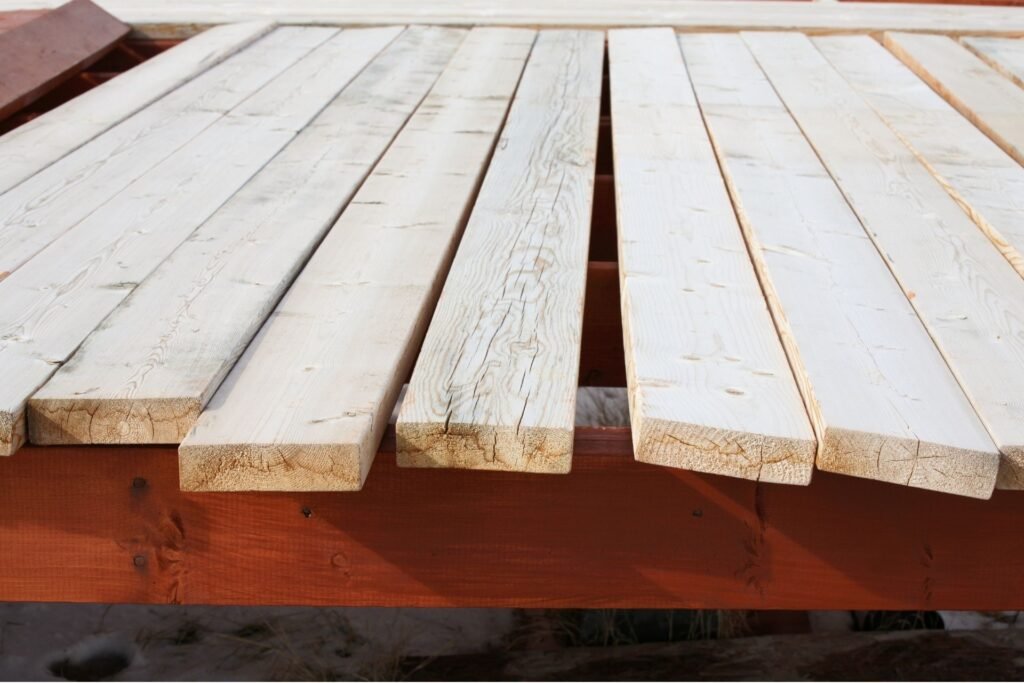
FAQs: About Timber Vs Composite Decking Australia
Timber decking is made from natural wood, offering a classic, warm aesthetic but requires regular maintenance to combat weather, pests, and decay. Composite decking is a blend of wood fibers and plastic, designed to mimic wood’s appearance with greater durability and less maintenance.
Australia’s harsh climate, characterized by extreme sun exposure, heavy rains, and high humidity, can impact decking materials. Timber may require more upkeep to maintain its appearance and integrity, while composite materials often offer greater resistance to weather-related wear and tear.
Yes, both timber and composite decking have environmentally friendly options. For timber, choosing locally sourced, sustainably harvested wood is key. Composite decking often includes recycled materials, making it a greener choice for those concerned about plastic use and waste.
Initially, timber decking can be less expensive than composite decking. However, when considering long-term maintenance, repair, and replacement costs, composite decking may be more cost-effective due to its durability and low maintenance requirements.
Composite decking can retain more heat than timber, especially in darker colors. It’s important to choose lighter shades for areas exposed to direct sunlight and consider the placement of your decking to minimize discomfort during hot days.
The lifespan of a timber deck varies based on maintenance and environmental factors but typically ranges from 10 to 15 years. Composite decking, on the other hand, can last 25 years or more, with many manufacturers offering extensive warranties.
Timber decking requires annual cleaning, staining, or sealing to protect against moisture, UV damage, and pests. Regular inspections for signs of wear, decay, or damage are also necessary to maintain its condition.
While composite decking is low maintenance, it’s not entirely maintenance-free. It requires occasional cleaning to prevent mold growth and to remove dirt and debris. However, it does not require staining, sealing, or sanding.
Popular choices for timber decking in Australia include Merbau, Spotted Gum, and Jarrah due to their durability, resistance to pests, and suitability for outdoor use. These species also offer beautiful natural colors and grains.
While DIY installation is possible, especially for composite decking, hiring a professional is recommended to ensure the job is done correctly. Professionals can ensure that your deck complies with local building codes, is structurally sound, and maximizes the material’s lifespan.
Conclusion
Selecting the ideal decking material for your home in Australia is a nuanced decision that balances aesthetic preferences with practical considerations. Timber decking offers natural beauty and a traditional charm but requires regular maintenance to withstand the Australian climate, whereas composite decking provides durability and low maintenance, albeit with a slightly less authentic look. Your choice should reflect not only your personal style and lifestyle needs but also take into account the specific environmental conditions of your location. Consulting with a decking professional can provide tailored advice, helping you navigate through the options to find a solution that harmonizes with your desires, lifestyle, and the unique climate challenges of Australia. Ultimately, whether you’re drawn to the classic allure of timber or the resilient convenience of composite materials, the right choice will enrich your outdoor living space, making it a cherished extension of your home.
Menu
- About
- Blog
- Contact Us
- Deck Builders Blue Mountains
- Patio Builders Blue Mountains
- Patio Builders Penrith
- Pergola Builders Blue Mountains
- Pergola Builders Penrith
- Privacy Policy
- Sitemap
- Terms And Conditions
About the Author:
Mike Veail is a recognized digital marketing expert with over 6 years of experience in helping tradespeople and small businesses thrive online. A former quantity surveyor, Mike combines deep industry knowledge with hands-on expertise in SEO and Google Ads. His marketing strategies are tailored to the specific needs of the trades sector, helping businesses increase visibility and generate more leads through proven, ethical methods.
Mike has successfully partnered with numerous companies, establishing a track record of delivering measurable results. His work has been featured across various platforms that showcase his expertise in lead generation and online marketing for the trades sector.
Learn more about Mike's experience and services at https://theleadguy.online or follow him on social media:

